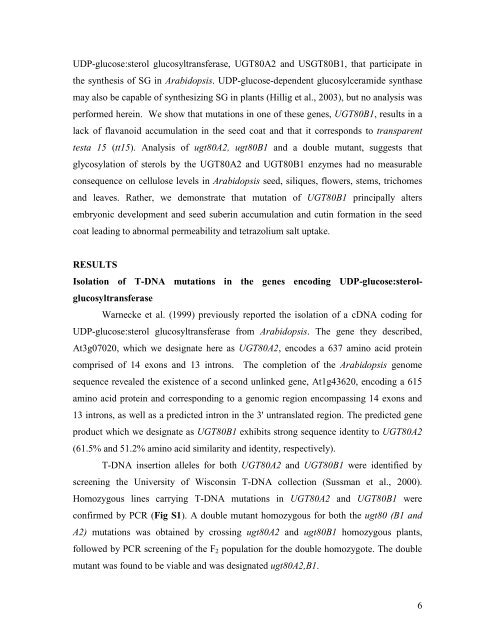1 Running head: Steryl glycoside mutants Name: Seth DeBolt ...
1 Running head: Steryl glycoside mutants Name: Seth DeBolt ...
1 Running head: Steryl glycoside mutants Name: Seth DeBolt ...
Create successful ePaper yourself
Turn your PDF publications into a flip-book with our unique Google optimized e-Paper software.
UDP-glucose:sterol glucosyltransferase, UGT80A2 and USGT80B1, that participate in<br />
the synthesis of SG in Arabidopsis. UDP-glucose-dependent glucosylceramide synthase<br />
may also be capable of synthesizing SG in plants (Hillig et al., 2003), but no analysis was<br />
performed herein. We show that mutations in one of these genes, UGT80B1, results in a<br />
lack of flavanoid accumulation in the seed coat and that it corresponds to transparent<br />
testa 15 (tt15). Analysis of ugt80A2, ugt80B1 and a double mutant, suggests that<br />
glycosylation of sterols by the UGT80A2 and UGT80B1 enzymes had no measurable<br />
consequence on cellulose levels in Arabidopsis seed, siliques, flowers, stems, trichomes<br />
and leaves. Rather, we demonstrate that mutation of UGT80B1 principally alters<br />
embryonic development and seed suberin accumulation and cutin formation in the seed<br />
coat leading to abnormal permeability and tetrazolium salt uptake.<br />
RESULTS<br />
Isolation of T-DNA mutations in the genes encoding UDP-glucose:sterolglucosyltransferase<br />
Warnecke et al. (1999) previously reported the isolation of a cDNA coding for<br />
UDP-glucose:sterol glucosyltransferase from Arabidopsis. The gene they described,<br />
At3g07020, which we designate here as UGT80A2, encodes a 637 amino acid protein<br />
comprised of 14 exons and 13 introns. The completion of the Arabidopsis genome<br />
sequence revealed the existence of a second unlinked gene, At1g43620, encoding a 615<br />
amino acid protein and corresponding to a genomic region encompassing 14 exons and<br />
13 introns, as well as a predicted intron in the 3' untranslated region. The predicted gene<br />
product which we designate as UGT80B1 exhibits strong sequence identity to UGT80A2<br />
(61.5% and 51.2% amino acid similarity and identity, respectively).<br />
T-DNA insertion alleles for both UGT80A2 and UGT80B1 were identified by<br />
screening the University of Wisconsin T-DNA collection (Sussman et al., 2000).<br />
Homozygous lines carrying T-DNA mutations in UGT80A2 and UGT80B1 were<br />
confirmed by PCR (Fig S1). A double mutant homozygous for both the ugt80 (B1 and<br />
A2) mutations was obtained by crossing ugt80A2 and ugt80B1 homozygous plants,<br />
followed by PCR screening of the F2 population for the double homozygote. The double<br />
mutant was found to be viable and was designated ugt80A2,B1.<br />
6

















